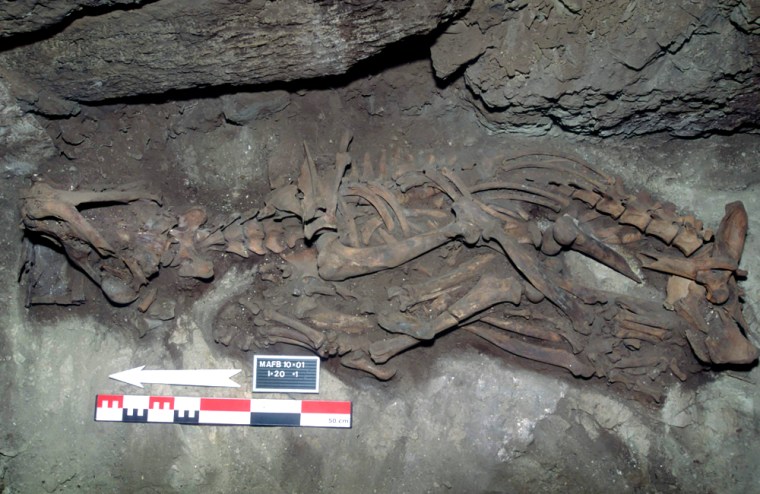Some had names like “Slayer of his Foes” and accompanied the pharaoh into battle. Thousands more were hunted as a ritual of bravery and strength. But only one apparently served as an eternal guardian.
A French archaeologist says his discovery of the first preserved lion skeleton in an ancient Egyptian tomb demonstrates the exalted reputation enjoyed by the King of Beasts more than 3,000 years ago.
“It confirms the status of the lion as a sacred animal,” Alain Zivie reports in Thursday’s issue of the journal Nature.
Zivie’s research team discovered the lion’s remains in 2001 as they excavated the tomb of Maia, wet nurse to Tutankhamun, the “boy king” popular with museum visitors today for his opulent gold funeral relics. He ruled for 10 years and died around 1323 B.C.
The tombs associated with King Tut are located south of Cairo at the Saqqara cemetery site across the Nile River from Memphis, ancient Egypt’s first capital. Zivie found Maia’s elaborate tomb in 1996.
Inscriptions in ancient Egypt mention the breeding and burial of lions, but no lion remains previously had been found, Zivie said.
Discovery provides important insight
The complete and undisturbed lion skeleton was found in an area of the tomb dedicated to the cat goddess Bastet, which also contained vast quantities of bones of humans and animals, including many cats.
The lion’s bones were not wrapped in linen bandages familiar to human mummies. But the bones’ position along with their coloration and mineral deposits on their surface are similar to those of other mummified cats discovered at Saqqara.
Zivie said the worn condition of the bones and teeth suggest it lived to an old age and was kept in captivity. The lion is not believed to have belonged to Maia, but is thought to have been placed in the tomb much later.
The lion may have been considered an incarnation of the god Mahes, the son of Bastet, Zivie said.
An Egyptologist who did not work on the specimen said the discovery was an important addition to knowledge of ancient ritual.
Archaeologists previously have found vast cemeteries for baboons, ibis, fish, smaller cats, dogs and crocodiles. Mummifying a large animal like a lion would have been an expensive and elaborate task.
“This is not any old lion, it’s an important lion,” said Emily Teeter, an Egyptologist at the University of Chicago.
Questions unanswered
Other researchers said Zivie’s report leaves several questions unanswered.
Robert Pickering, a forensic anthropologist with the Buffalo Bill Historical Center in Cody, Wyo., said the bones’ discoloration is “irrelevant” because they would have been influenced by the tomb’s environment over thousands of years. The lack of linen wrapping and soft tissue preservation also does not support mummification, he said.
“It seems to be treated different from other animals that were entombed as part of ritual,” Pickering said. “Maybe this lion’s importance is as a family pet rather than as a representative of a god. The context doesn’t seem to fit.”
Hunters nearly exterminated regional lion populations by 1100 B.C. Commemorative artwork has been found telling of how the pharaoh Amenhotep III killed more than 100 during a single hunt. Ramses the Great, meanwhile, had a pet lion named “Slayer of his Foes,” Teeter said.
“It’s hard for people to understand that they are killing, sacrificing, a symbol of the god,” Teeter said. “But they didn’t see it as killing the god.”
